Canon EOS R6 Review

Introduction
Launched alongside the flagship EOS R5, the new Canon R6 has been somewhat overshadowed by its 8K-recording big brother, but out of the two cameras is probably the one that will find itself in the hands of more photographers.
A price-tag of £2499.99 body-only in the UK and $2499 in the US makes the Canon EOS R6 a much more affordable proposition, positioning it below the EOS R5 and above the EOS R and the entry-level EOS RP in the four camera Canon full-frame mirrorless range.
You can also choose to pay £2849.99 with the RF 24-105 STM kit lens in the UK, or $2899.99 with the RF 24-105 STM kit lens and $3599.99 with the RF 24-105mm f/4L IS USM lens in the US.
The EOS R6 will be available to buy on 27th August 2020. We've already got our hands on a full-production camera for testing, along with the versatile RF 24-105mm F4-7.1 IS STM lens.
So read on for our full Canon R6 review!
Ease of Use
 |
| Front of the Canon EOS R6 |
Despite the Canon R6 utilising a polycarbonate body rather than the EOS R5's more robust magnesium-alloy body, impressively it still offers the same level of weather-proofing as the EOS 6D Mark II and the 5D Mark IV DSLR cameras.
Therefore it benefits from being both lightweight - 598g body-only or 680g with both a battery and memory card fitted - and fully weather-sealed.
It measures 138.4 x 97.5 x 88.4 mm, making it slightly bigger than both the EOS R and especially the tiny RP, no doubt in order to accommodate the new IBIS unit.
The Canon R6 benefits from having a very deep handgrip that comfortably accommodates four fingers, something that can't be said of a lot of mirrorless cameras that suffer from having too small a grip.
The minimalist front plate sports just a single control - the classic Depth of Field preview button, which helps you determine what your photos will look like before the image is taken.
There's also a porthole for the AF assist light and a lozenge shaped button for releasing the lens.
At the heart of the EOS R6 is a 20 megapixel sensor that's very similar to the one found in the flagship EOS-1D X Mark III DSLR camera, but with a different, less sophisticated low-pass filter.
Our only real concern with the sensor inside the Canon R6 is whether or not it's of high enough resolution for its general enthusiast target market, especially if you like to heavily crop your images in post-production.
 |
| Rear of the Canon EOS R6 |
The ISO range runs from 100-102,400, which is actually one stop more than the flagship EOS R5. This can be further expanded up to ISO 204,800 and down to ISO 50.
For the first time ever in the EOS series (alongside the EOS R5), the Canon R6 finally incorporates 5-axis In-Body Image Stabilisation (IBIS). The EOS R and RP both eschewed this much-requested feature,
It has been designed to work collaboratively with the IS system that's built into many RF-mount lenses, with the lens and the sensor working together to correct pitch and yaw and the sensor correcting the X-Y and roll movements.
This intelligent stabilisation system provides a frankly incredible 8-stops of stabilisation with some lenses, allowing you to hand-hold the camera for up to 4 seconds and still get critically sharp results.
Even some non-stabilised lenses such as the RF 85mm F1.2L USM or RF 28-70mm F2L USM offer 8 stops of stabilisation when they're mounted on the EOS R6, thanks to the large 54mm diameter of the of the RF Mount.
The EOS R6 can also stabilise older, non-IS lenses including any EF lens that is fitted to the R6 via the Canon EF-EOS R mount adapter.
The stabilisation system will also work with lenses from other manufacturers – you just need to input the focal length into the camera's menu system.
In practice, the Canon EOS R6 and the RF 24-105mm F4-7.1 IS STM lens that we were sent for testing provided up to the headline grabbing 8-stops of stabilisation - it really is possible to hand-hold this combination at previously impossibly slow shutter speeds and still maintain critical sharpness.
 |
| Top of the Canon EOS R6 |
The fact that this can be achieved using the affordable and versatile 24-105mm kit lens instantly makes it our top recommendation if you're buying the EOS R6 and you don't already have any Canon lenses.
Another very impressive headline feature is the Canon EOS R6's ability to continuously shooting at up to 20fps using its silent electronic shutter, or 12fps with the mechanical shutter, both with full auto exposure (AE) and auto focus (AF) tracking.
There's a tiny amount of viewfinder and LCD blackout between each frame when shooting at 20fps, but it's barely discernible to the naked eye.
Incredibly the Canon R6 can record 1,000 or more compressed raw images at 12fps before its buffer becomes full, almost three times as many images as the flagship EOS R5.
The size of your memory card effectively becomes the limiting factor on how many images the EOS R6 can take in one continuous sequence.
Obviously there's a big difference in the megapixel count, but for sheer shooting speed and buffer depth, the EOS R6 clearly wins out.
Along with the EOS R5, the R6 is the first Canon camera to feature the next generation Dual Pixel CMOS AF II focusing system.
Billed as the world’s fastest AF, the camera is capable of focusing in as little as 0.05 seconds.
 |
| Tilting LCD Screen |
It has 6,072 selectable AF points, which is slightly more than the EOS R5, with 100% frame coverage.
Impressively the Canon R6 can also focus in light levels as low as -6.5EV (when used with an F1.2 lens), which is 0.5-stop better than the EOS R5.
Thanks to its brand new Digic X processor, the EOS R6 offers the same deep-learning based automatic face, eye and animal AF tracking modes as the R5.
The Canon R6 can now recognise and track eyes from much further away than previous models, and subject tracking works for humans and also dogs, cats and birds, the latter even in flight.
In practice we found both the new eye AF and animal subject tracking system to be on par with that found in Sony Alpha cameras, which have long been the leader in this area, so kudos to Canon for catching up so quickly.
In terms of its exterior design, the new Canon EOS R6 brings together the rear panel from the EOS R5 and the top plate from the EOS RP.
So instead of the LCD status panel and Mode button found on the top-right of the EOS R5, the R6 has a much more conventional shooting mode dial in place of the LCD panel, which we actually prefer, and which we think a lot of photographers will prefer.
It's undeniably quicker to change the shooting mode using an external dial, rather than having to press a button and navigate through an electronic menu.
 |
| Memory Card Slots |
The main downside is not being able to see the current camera settings by simply glancing down at the top-plate LCD.
Both a shooting mode dial and a top-plate LCD screen would be ideal, but EOS R camera bodies are simply too small to accommodate them together.
Most of the other controls on top of the EOS R6 are identical or very similar to those found on the entry-level EOS RP.
So there's a small On/Off switch over on the top-left, with the camera leaping into life almost instantly.
In addition to the shooting mode dial on the top-right are the same six controls found on the EOS RP.
There's a small but responsive shutter release button at the top of the handgrip, with the tiny M-Fn behind it. This provides quick access to some of the camera's key controls, including ISO, continuous shooting, AF, white balance and exposure compensation.
Behind that is the front control dial for principally setting the aperture or shutter speed, with a small, red one-touch movie record button sitting proud of the camera body.
The Lock switch on the EOS RP has now become a Lock button on the new Canon EOS R6. As its name suggests, this locks the two control dials on top of the camera and the rear control wheel so that you can't accidentally change the camera's key settings.
 |
| Front of the Canon EOS R6 |
Completing the top of the camera is the rear control dial that's ideally placed for thumb operation.
Overall, the Canon EOS R6's top-plate is a successful continuation of the design philosophy that Canon have implemented on the previous EOS RP and EOS R cameras, with the main differences being a shooting mode dial rather than an LCD screen, and a Lock button rather than a Lock switch.
Turning to the rear of the Canon R6, it offers an array of controls that will be instantly familiar to anyone who has used an EOS 5-series DSLR camera before, including the classic Canon control wheel. There's also a very welcome joystick instead of the controversial Mfn bar found on the EOS R.
Joining the Menu bottom on the far left is a new Rate button, which allows you to assign star ratings to your images during playback (Off, 1-5 stars).
Although not quite as highly specced as the one on the EOS R5, the 0.5inch 3.69 million dot EVF on the EOS R6 is still impressive to look through, working up to 120fps for minimal lag when shooting fast-moving subjects.
To the right of the electronic viewfinder is the new thumb operated joystick.
This means that the innovative / controversial (delete as appropriate) Mfn bar that made its debut on the EOS R is conspicuous by its complete absence on the new EOS R6, and indeed on the new EOS R5 too.
We'd be very surprised if the Mfn bar ever appears again on a Canon camera, so if you're a fan, the EOS R is the only camera for you.
 |
| Bottom of the Canon EOS R6 |
While the inclusion of the joystick is very welcome, we were struck by just how high the joystick is positioned. It's almost inline with the centre of the viewfinder, rather than where the Magnification button is, which at least initially seems rather too high to find easily, especially compared with most other cameras that have this key control.
We eventually got used to it higher position, but still can't help feeling that it was lower down.
The other main control innovation on the EOS R6 is the return of the classic Canon control wheel with the SET button at its heart, something that the previous EOS R and RP models both lacked.
This will be instantly familiar to anyone who has used a Canon EOS 5-series DSLR camera before.
The one on the EOS R6 actually serves less purpose than the one on the EOS 5-series, though, simply because there are already two control dials on top of the camera for setting the aperture and shutter speed, and one on the RF lenses which can be usefully configured to control the ISO speed, amongst other things.
So the classic Canon control wheel is mainly used for quickly scrolling through the menu system and during image playback instead.
As the camera also has a touch-screen, both of these functions can be more quickly and intuitively controlled via touch, which does beg the question as to why Canon decided to include the control wheel at all. Nostalgia, perhaps?
The EOS R6 has a pretty well-specced 3-inch, 1.62 million dot, vari-angle LCD screen which tilts out to the side and faces forwards for more convenient vlogging and selfies.
 |
| Tilting LCD Screen |
It can also be usefully folded flat against the back of the camera to protect it when in transit in a camera bag.
A proximity sensor is located directly beneath the viewfinder, which automatically switches between the EVF and LCD screen. When the LCD screen is swung outwards, the EVF is cleverly turned off automatically.
A tilting LCD screen always helps to encourage shooting from creative angles and it also helps make the EOS R6 ideally suited to movie-shooting.
As mentioned above, the LCD screen is touch-sensitive, allowing you to control everything from setting the AF point and firing the shutter, navigating the menu systems and browsing your images during playback. It's a very precise, responsive system that's a veritable joy to use.
Alongside the rear joystick are three classic Canon controls - the AF-On button for people who prefer back-button focusing, the Auto-exposure Lock button (denoted by a star) and the AF area selection button which makes it easier to switch the autofocus point when holding the camera to your eye.
Underneath the AF-On button are a cluster of three buttons - the Magnification button, Info Button and the Quick button which opens the Quick Control screen, which provides instant access to 10 key camera controls.
Completing the rear of the EOS R6 are the self-explanatory Playback and Delete buttons located underneath the rear control wheel.
On the right hand-side of the camera is the memory card compartment. The EOS R6 supports two SD UHS II cards via dual slots, which instantly promotes it above the EOS R, which only has a single slot, and you can choose to record to both cards simultaneously.
 |
| Front of the Canon EOS R6 |
On the left hand-side of the camera are three rubber flaps housing five different connections.
The Canon EOS R6 has a microphone port, headphone jack, remote control port, USB-3 port and a HDMI connection - all the things that any enthusiast photographer or videographer would need from a connectivity point of view.
The Canon R6 benefits from using the LP-E6NH, a new longer life battery that is supplied with both the EOS R6 and EOS R5 cameras.
The LP-E6NH effectively replaces the existing LP-E6N, reaching 2130mAh and offering an increased capacity of 14%. In reality this translates into 380 shots when using the EVF and 510 when using the LCD screen.
Thankfully it's also backwards compatible with all existing cameras that use the LP-E6 series batteries,so you can use an older LP-E6N in the EOS R6, and the new LP-E6NH in an older EOS camera that uses the LP-E6N. All of the various chargers are cross-compatible too.
If one battery isn't enough for you, the EOS R6 is compatible with the brand new BG-R10 Battery Grip.
This is exactly the same battery grip that the new EOS R5 also uses.
It gives users the ability to power the EOS R6 using two batteries (LP-E6/N/NH) and also offers duplicate controls for easier vertical shooting. Note that the batteries have to be charged whilst the grip is fitted on-camera.
 |
| Front of the Canon EOS R6 |
With built-in Bluetooth and 2.4Ghz Wi-Fi, the EOS R6 can be easily connected to a smartphone and networks allowing high-speed file sharing and FTP/FTPS transfer. Note that the R6 doesn't offer support for the faster 5Ghz Wi-fi standard that the EOS R5 does.
The R6 can also be remotely controlled using Canon's Camera Connect and EOS Utility apps and tethered to a PC or Mac via Wi-Fi or high-speed USB 3.1.
While video isn't the primary focus of the EOS R6, unlike the 8K RAW recording EOS R5, it still offers the impressive ability to record uncropped 4K UHD / 60p / 10-bit footage internally with dual-pixel auto-focus and auto-exposure for up to 30 minutes.
Full 1080 slow-motion recording at up to 120p with autofocus is also available (but no sound), which is actually something that the flagship EOS R5 doesn't offer.
Canon Log gamma is available to provide extra flexibility for colour grading in post-production.
Canon have also added zebra display during movie shooting, which can be used as a guide to exposure adjustment, especially for highlights.
For many videographers this headline specification will be more than enough for their uses, and it represents a big leap forwards from the video recording capabilities of the EOS R and RP cameras.
Overall, the new Canon EOS R6 successfully incorporates a lot of the "classic" Canon handling that DSLR owners know and love, with a well-balanced specification that improves exponentially on the EOS R. The EOS R5 may be grabbing all the headlines at the moment, but the R6 delivers nearly all of the features that most photographers want at a much more affordable price point.
Image Quality
All of the sample images in this review were taken using the 20.1 megapixel Fine JPEG setting, which gives an average image size of around 7Mb.
The Canon EOS R6 produced still images of outstanding quality during the review period.
Thanks to its modest 20 megapixel sensor, this camera produces noise-free JPEG images from ISO 50 all the way up to ISO 12800, with noise first appearing at ISO 25600. The faster settings of 51200 and 102400 display quite a lot of noise, but they're still fine to use for making smaller prints and web images. Even the fastest expanded setting of ISO 204800 can be used at a push.
The EOS R6 proved to very capable in low-light, with the maximum shutter speed of 30 seconds and the Bulb mode allowing you to capture enough light in all situations and the camera's -6.5EV rating successfully auto-focusing even in near-dark conditions.
The different Picture Styles and the ability to create your own are a real benefit, as are the HDR settings and multiple exposure mode, all of which can be previewed before you take the shot. Support for the new HEIF 10-bit file format is a little thin on the ground, but should offer a degree of future-proofing.
Noise
ISO sensitivity can be set between ISO 50 and ISO 204800 in full-stop increments. Here are some 100% crops which show the noise levels for each ISO setting, with JPEG on the left and RAW on the right.
| JPEG | RAW |
ISO 50 (100% Crop) |
ISO 50 (100% Crop) |
 |
 |
ISO 100 (100% Crop) |
ISO 100 (100% Crop) |
 |
 |
ISO 200 (100% Crop) |
ISO 200 (100% Crop) |
 |
 |
ISO 400 (100% Crop) |
ISO 400 (100% Crop) |
 |
 |
ISO 800 (100% Crop) |
ISO 800 (100% Crop) |
 |
 |
ISO 1600 (100% Crop) |
ISO 1600 (100% Crop) |
 |
 |
ISO 3200 (100% Crop) |
ISO 3200 (100% Crop) |
 |
 |
ISO 6400 (100% Crop) |
ISO 6400 (100% Crop) |
 |
 |
ISO 12800 (100% Crop) |
ISO 12800 (100% Crop) |
 |
 |
ISO 25600 (100% Crop) |
ISO 25600 (100% Crop) |
 |
 |
ISO 51200 (100% Crop) |
ISO 51200 (100% Crop) |
 |
 |
ISO 102400 (100% Crop) |
ISO 102400 (100% Crop) |
 |
 |
ISO 204800 (100% Crop) |
ISO 204800 (100% Crop) |
 |
 |
File Quality
The Canon EOS R6 has three different file quality settings - Raw, Fine and Normal. Here are some 100% crops which show the difference.
| Fine (13.7Mb) (100% Crop) | Normal (8.37Mb) (100% Crop) |
 |
 |
| RAW (55.7Mb) (100% Crop) | |
 |
JPEG vs HEIF
Compared with the 8 bits (256-level greyscale) of the JPEG format, HEIF is capable of storing image data at 10 bits (1024-level greyscale) or higher, and also supports the Rec. 2020 standard, which boasts an extremely wide color gamut.
What’s more, HEIF is compatible with the HEVC (H.265) codec, which offers a higher compression efficiency in storage compared with JPEG files of the same image quality.

JPEG

HEIF
Night
The Canon EOS R6's maximum shutter speed is 30 seconds and there's a Bulb mode for even longer exposures, which is excellent news if you're seriously interested in low light photography.

HDR
The Canon EOS R6's HDR Mode captures three different exposures and combines them into one, retaining more shadow and highlight detail, with an Auto mode, three different strengths and several types of HDR style available.
Off |
 |
1EV |
 |
2EV |
 |
3EV |
 |
Multiple Exposure
The EOS R6's multiple exposure mode allows you to take between two and nine images and merge them into a single photo in-camera.

Picture Styles
Canon's Picture Controls are preset combinations of different sharpness, contrast, saturation and colour tone settings. The EOS R6's seven available Picture Controls are shown below in the following series, which demonstrates the differences. There are also three User Defined styes so that you can create your own look.
Standard |
 |
Portrait |
 |
Landscape |
 |
Fine Detail |
 |
Faithful |
 |
Neutral |
 |
Monochrome |
 |
Sample Images
This is a selection of sample images from the Canon EOS R6 camera, which were all taken using the 20 megapixel Fine JPEG setting. The thumbnails below link to the full-sized versions, which have not been altered in any way.
1/10s · f/11 · ISO 200
105mm
Download Original
1/160s · f/8 · ISO 200
105mm
Download Original
1/100s · f/7.1 · ISO 200
85mm
Download Original
1/160s · f/7.1 · ISO 100
85mm
Download Original
1/160s · f/7.1 · ISO 2000
105mm
Download Original
1/100s · f/7.1 · ISO 100
90mm
Download Original
1/160s · f/7.1 · ISO 400
105mm
Download Original
1/125s · f/7.1 · ISO 160
105mm
Download Original
1/250s · f/7.1 · ISO 100
105mm
Download Original
1/160s · f/7.1 · ISO 400
105mm
Download Original
1/160s · f/7.1 · ISO 320
105mm
Download Original
1/125s · f/7.1 · ISO 250
105mm
Download Original
1/125s · f/11 · ISO 250
105mm
Download Original
1/160s · f/11 · ISO 640
105mm
Download Original
1/160s · f/7.1 · ISO 1000
105mm
Download Original
1/125s · f/7.1 · ISO 1000
105mm
Download Original
1/80s · f/16 · ISO 250
76mm
Download Original
1/160s · f/11 · ISO 1250
105mm
Download Original
1/320s · f/11 · ISO 100
24mm
Download Original
1/125s · f/11 · ISO 100
105mm
Download Original
1/160s · f/7.1 · ISO 200
105mm
Download Original
1/320s · f/7.1 · ISO 100
105mm
Download Original
1/1000s · f/4 · ISO 100
24mm
Download Original
1/200s · f/7.1 · ISO 100
105mm
Download Original
1/160s · f/7.1 · ISO 100
105mm
Download Original
1/200s · f/11 · ISO 100
24mm
Download Original
1/160s · f/11 · ISO 100
99mm
Download Original
1/200s · f/8 · ISO 100
105mm
Download Original
1/320s · f/6.3 · ISO 100
63mm
Download Original
1/60s · f/8 · ISO 320
38mm
Download Original
1/125s · f/16 · ISO 320
105mm
Download Original
1/60s · f/11 · ISO 160
24mm
Download Original
1/160s · f/6.3 · ISO 100
70mm
Download Original
1/400s · f/11 · ISO 100
105mm
Download Original
1/125s · f/11 · ISO 100
105mm
Download Original
1/200s · f/11 · ISO 100
24mm
Download Original
1/160s · f/7.1 · ISO 125
105mm
Download Original
1/320s · f/7.1 · ISO 100
105mm
Download Original
1/320s · f/7.1 · ISO 100
57mm
Download Original
1/1250s · f/4 · ISO 100
24mm
Download Original
1/250s · f/8 · ISO 100
27mm
Download Original
1/125s · f/7.1 · ISO 125
105mm
Download Original
1/100s · f/7.1 · ISO 100
73mm
Download Original
1/60s · f/7.1 · ISO 200
52mm
Download Original
1/100s · f/7.1 · ISO 100
76mm
Download Original
1/100s · f/7.1 · ISO 100
76mm
Download Original
1/160s · f/7.1 · ISO 200
105mm
Download Original
1/500s · f/7.1 · ISO 100
105mm
Download Original
1/500s · f/7.1 · ISO 100
54mm
Download Original
1/60s · f/8 · ISO 200
24mm
Download Original
1/60s · f/11 · ISO 125
24mm
Download Original
1/80s · f/11 · ISO 160
24mm
Download Original
1/60s · f/11 · ISO 200
24mm
Download Original
1/160s · f/11 · ISO 640
105mm
Download Original
1/160s · f/7.1 · ISO 100
105mm
Download Original
Sample RAW Images
The Canon EOS R6 enables users to capture RAW and JPEG format files. We've provided some Canon RAW (CR3) samples for you to download (thumbnail images shown below are not 100% representative).
1/10s · f/11 · ISO 200
105mm
Download original
1/160s · f/8 · ISO 200
105mm
Download original
1/100s · f/7.1 · ISO 200
85mm
Download original
1/160s · f/7.1 · ISO 100
85mm
Download original
1/160s · f/7.1 · ISO 2000
105mm
Download original
1/100s · f/7.1 · ISO 100
90mm
Download original
1/160s · f/7.1 · ISO 400
105mm
Download original
1/125s · f/7.1 · ISO 160
105mm
Download original
1/250s · f/7.1 · ISO 100
105mm
Download original
1/160s · f/7.1 · ISO 400
105mm
Download original
1/160s · f/7.1 · ISO 320
105mm
Download original
1/125s · f/7.1 · ISO 250
105mm
Download original
1/125s · f/11 · ISO 250
105mm
Download original
1/160s · f/11 · ISO 640
105mm
Download original
1/160s · f/7.1 · ISO 1000
105mm
Download original
1/125s · f/7.1 · ISO 1000
105mm
Download original
1/80s · f/16 · ISO 250
76mm
Download original
1/160s · f/11 · ISO 1250
105mm
Download original
1/320s · f/11 · ISO 100
24mm
Download original
1/125s · f/11 · ISO 100
105mm
Download original
1/160s · f/7.1 · ISO 200
105mm
Download original
1/320s · f/7.1 · ISO 100
105mm
Download original
1/1000s · f/4 · ISO 100
24mm
Download original
1/200s · f/7.1 · ISO 100
105mm
Download original
1/160s · f/7.1 · ISO 100
105mm
Download original
1/200s · f/11 · ISO 100
24mm
Download original
1/160s · f/11 · ISO 100
99mm
Download original
1/200s · f/8 · ISO 100
105mm
Download original
1/320s · f/6.3 · ISO 100
63mm
Download original
1/60s · f/8 · ISO 320
38mm
Download original
1/125s · f/16 · ISO 320
105mm
Download original
1/60s · f/11 · ISO 160
24mm
Download original
1/160s · f/6.3 · ISO 100
70mm
Download original
1/400s · f/11 · ISO 100
105mm
Download original
1/125s · f/11 · ISO 100
105mm
Download original
1/200s · f/11 · ISO 100
24mm
Download original
1/160s · f/7.1 · ISO 125
105mm
Download original
1/320s · f/7.1 · ISO 100
105mm
Download original
1/320s · f/7.1 · ISO 100
57mm
Download original
1/1250s · f/4 · ISO 100
24mm
Download original
1/250s · f/8 · ISO 100
27mm
Download original
1/125s · f/7.1 · ISO 125
105mm
Download original
1/100s · f/7.1 · ISO 100
73mm
Download original
1/60s · f/7.1 · ISO 200
52mm
Download original
1/100s · f/7.1 · ISO 100
76mm
Download original
1/100s · f/7.1 · ISO 100
76mm
Download original
1/160s · f/7.1 · ISO 200
105mm
Download original
1/500s · f/7.1 · ISO 100
105mm
Download original
1/500s · f/7.1 · ISO 100
54mm
Download original
1/60s · f/8 · ISO 200
24mm
Download original
1/60s · f/11 · ISO 125
24mm
Download original
1/80s · f/11 · ISO 160
24mm
Download original
1/60s · f/11 · ISO 200
24mm
Download original
1/160s · f/11 · ISO 640
105mm
Download original
1/160s · f/7.1 · ISO 100
105mm
Download original
Sample Movies & Video
This is a sample movie at the highest quality setting of 3840x2160 pixels at 60 frames per second. Please note that this 24 second movie is 687Mb in size.
This is a sample movie at the highest quality setting of 3840x2160 pixels at 60 frames per second. Please note that this17 second movie is 489Mb in size.
This is a sample movie at the highest quality setting of 3840x2160 pixels at 60 frames per second. Please note that this 20 second movie is 558Mb in size.
This is a sample movie at the highest quality setting of 3840x2160 pixels at 60 frames per second. Please note that this 19 second movie is 553Mb in size.
This is a sample movie at the highest quality setting of 3840x2160 pixels at 60 frames per second. Please note that this 20 second movie is 562Mb in size.
This is a sample movie at the highest quality setting of 3840x2160 pixels at 60 frames per second. Please note that this 15 second movie is 438Mb in size.
This is a sample movie at the highest quality setting of 3840x2160 pixels at 60 frames per second. Please note that this 27 second movie is 773Mb in size.
This is a sample movie at the quality setting of 3840x2160 pixels at 50 frames per second. Please note that this 20 second movie is 530Mb in size.
This is a sample movie at the quality setting of 3840x2160 pixels at 50 frames per second. Please note that this 15 second movie is 411Mb in size.
This is a sample slow-motion movie at the quality setting of 1920x1080 pixels at 100 frames per second. Please note that this 20 second movie is 280Mb in size.
This is a sample slow-motion movie at the quality setting of 1920x1080 pixels at 100 frames per second. Please note that this 15 second movie is 207Mb in size.
Product Images



























Conclusion
The new EOS R6 is the best full-frame mirrorless Canon camera to date, and unless you really need 8K video, the camera that mid-range DSLR owners should buy if they're looking to switch to mirrorless.
While the flagship R5 is currently getting all the plaudits (and some criticism) for its world-beating video specs, the Canon R6 is a much more affordable proposition that still delivers almost everything that an enthusiast photographer or videographer could possibly want.
And while the first generation EOS R and RP represented a marked and ultimately flawed departure from Canon's proven handling and ease of use, the new EOS R6 thankfully marks a return to form, mixing together the best of its DSLR and mirrorless user interfaces into one mostly coherent whole.
Sporting no less than three control dials and wheels, a joystick and touch-screen LCD, not to mention the control ring found on RF lenses, it's clear that the Canon R6 is one of the most customisable cameras that we've ever reviewed.
With the handling well and truly nailed, the EOS R6's feature-set is likewise well thought out - more than good enough to take on the competition, but not so overblown as to be out of reach financially for most would-be buyers.
Thankfully the Canon R6 achieves its full potential in most areas, with the new AF, IBIS and continuous shooting systems in particular being worthy of praise. This model really has taken a giant stride forwards for Canon cameras as a whole, moving beyond what 5-series DSLRs and previous mirrorless cameras have been able to both offer and achieve.
That isn't to say that the EOS R6 is the perfect camera. Some photographers may feel that 20 megapixels doesn't offer quite enough resolution for their needs, whilst videographers may bemoan the need to let their camera cool down after shooting a long 4K UHD 60p clip. The plethora of controls on offer can at first seem overwhelming, whilst the camera is undeniably bigger than its main rivals.
All of this seems like nit-picking, however, when compared to everything that the EOS R6 does so well. The fact that this is also the first Canon full-frame mirrorless camera to feel like a DSLR, almost certainly a reaction to the criticism levelled at the EOS R, is a great decision.
Overall, the new EOS R6 is the mirrorless camera that the majority of Canon owners have been longing for, for so long.
| Ratings (out of 5) | |
|---|---|
| Design | 5 |
| Features | 5 |
| Ease-of-use | 4.5 |
| Image quality | 5 |
| Value for money | 4.5 |
Main Rivals
Listed below are some of the rivals of the Canon EOS R6.
Canon EOS R
The EOS R is Canon's first ever full-frame mirrorless camera, joining the likes of Sony, Nikon and Panasonic. Can it beat its main rivals, and is it a real alternative to a more traditional DSLR? Find out now by reading our in-depth Canon EOS R review, complete with full-size sample images, videos and more...
Canon EOS R5
The EOS R5 has been the hottest full-frame camera on the block ever since Canon pre-announced it back at the start of 2020, thanks to its headline grabbing twin features of a 45 megapixel sensor and 8K video recording. We've seen it a few times since then, but now we can finally bring you our final Canon R5 review, complete with full-size sample photos and videos!
Nikon Z6
The Nikon Z6 mirrorless camera is the sensible little brother of the flagship Z7 model, offering less megapixels, fewer AF points and faster continuous shooting at a much lower price point. Is this the best balanced mirrorless camera on the market? Find out now by reading our in-depth Nikon Z6 review, complete with full size JPEGs, Raw files and movies...
Panasonic S1
The Panasonic S1 is the more sensibly specced and sensibly priced sibling of the flagship S1R full-frame mirrorless camera. It lowers the number of megapixels whilst upping the video capabilities, promising a more well-rounded camera at a more affordable price-point. Does the new Lumix S1 have what it takes to compete with the likes of the Sony A7 III, Nikon Z6 and Canon EOS R? Read our detailed Panasonic S1 review to find out...
Sony A7 III
The new A7 III is the most affordable Sony full-frame camera in the Alpha range, but as our in-depth review reveals, it's far from being the most basic. Find out why we think this is the best camera of 2018 (so far at least) by reading our in-depth Sony A7 III review...
Review Roundup
Reviews of the Canon EOS R6 from around the web.
dpreview.com »
The Canon EOS R6 is a 20MP full-frame mirrorless camera aimed at enthusiast photographers and videographers. It sits below the R5 much as the EOS 6Ds did beneath the 5D DSLRs, and offers a well-rounded combination of features for both disciplines.
Read the full review »
digitaltrends.com »
Canon had a bit of an identity crisis making the switch to full-frame mirrorless, with the throttled budget RP and good, but not very competitive, EOS R. The company’s second set of full-frame mirrorless cameras, however, appear to promise more of what Canon’s DSLRs were known for, and then some, with in-body image stabilization, 12 fps bursts, and the next generation of Dual Pixel autofocus inside the Canon EOS R6 and R5.
Read the full review »
cameralabs.com »
The EOS R6 may have been over-shadowed by the headline-grabbing R5, but quietly becomes one of the most compelling cameras in Canon’s range. Compared to the R5, it may lack the 45 Megapixels, 8k video, slow-motion 4k, more detailed viewfinder and slightly tougher build, but it’s more notable how much they have in common.
Read the full review »
digitalcameraworld.com »
The Canon EOS R6 is a versatile all-round camera that can shoot pretty much anything. Aside from a few differences, it's essentially an EOS R5 with lower resolution and less high-end video. If you're content with fewer megapixels, you'll enjoy one of the most advanced and impressive cameras we've ever seen.
Read the full review »
Specifications
Image Sensor
-
Type35.9 x 23.9 mm CMOS
-
Effective PixelsApprox. 20.1 megapixels
-
Total PixelsApprox. 21.4 megapixels
-
Aspect Ratio3:2
-
Low-Pass FilterBuilt-in/Fixed
-
Sensor CleaningEOS integrated cleaning system
-
Colour Filter TypePrimary Colour
-
Sensor Shift-ISYes, up to 8-Stops advantage depending on the lens used 1
Image Processor
-
TypeDIGIC X
Lens
-
Lens MountRF (EF and EF-S lenses can be attached using: Mount Adapter EF-EOS R
Control Ring Mount Adapter EF-EOS R
Drop-In Filter Mount Adapter EF-EOS R)
EF-M lenses are not compatible -
Focal LengthEquivalent to 1.0x the focal length of the lens with RF and EF lenses 1.6x with EF-S
Focusing
-
TypeDual Pixel CMOS AF
-
AF System / Points100% horizontal and 100% vertical with Face + Tracking and Auto Selection modes 100% horizontal and 90% vertical with manual selection and large zone modes 2
-
AF Working RangeEV -6.5 – 20 (at 23°C & ISO100) 3
-
AF ModesOne Shot Servo AF AI Focus AF (in A+ Scene Intelligent Auto mode )
-
AF Point SelectionAutomatic selection: Face + tracking. 1053 Available AF areas when automatically selected
Manual selection: 1-point AF (AF frame size can be changed) 6072 (stills)/ (4968) movie AF positions available
Manual selection: AF point Expansion 4 points (up, down, left, right)
Manual selection: AF point Expansion surrounding points
Manual selection: Zone AF (all AF points divided into 9 focusing zones)
Manual selection: Large Zone AF (Vertical)
Manual selection: Large Zone AF (Horizontal) -
AF LockLocked when shutter button is pressed halfway or AF ON is pressed in One Shot AF mode. Using customised button set to AF stop in AI servo
-
AF Assist BeamEmitted by built in LED or optional dedicated Speedlite (flash)
-
Manual FocusSelected on lens
Exposure Control
-
Metering ModesReal-time with image sensor, 384-zone metering.
(1) Evaluative metering (linked to All AF points)
(2) Partial metering (approx. 5.8% of viewfinder at centre)
(3) Spot metering: Centre spot metering (approx. 2.9% viewfinder at centre)
AF point-linked spot metering not provided
(4) Centre weighted average metering -
Metering Brightness RangeEV -3 – 20 (at 23°C, ISO100, with evaluative metering)
-
AE LockAuto: AE lock takes effect when focus is achieved
Manual: By AE lock button in P, Av, Fv, Tv and M modes -
Exposure Compensation+/-3 EV in 1/3 or 1/2 stop increments (can be combined with AEB)
-
AEB+/-3 EV in 1/3 or 1/2 stop increments
-
Anti-flicker ShootingYes. Flicker detected at a frequency of 100 Hz or 120 Hz. Maximum continuous shooting speed may decrease
-
ISO SensitivityAuto 100-102400 (in 1/3-stop or 1 stop increments)
ISO can be expanded to L:50, H:204,800
Shutter
-
TypeElectronically-controlled focal-plane shutter and Electronic shutter function on sensor
-
Speed30-1/8000 sec (1/2 or 1/3 stop increments), Bulb (Total shutter speed range. Available range varies by shooting mode)
-
Shutter ReleaseSoft touch electromagnetic release
White Balance
-
TypeAuto white balance with the imaging sensor
-
SettingsAWB (Ambience priority/White priority), Daylight, Shade, Cloudy, Tungsten light, White Fluorescent light, Flash, Custom, Colour Temperature Setting
White balance compensation:
1. Blue/Amber +/-10
2. Magenta/Green +/-10 -
Custom White BalanceYes, 1 setting can be registered
-
WB Bracketing+/-3 levels in single level increments
3, 2, 5 or 7 bracketed images per shutter release
Selectable Blue/Amber bias or Magenta/Green bias
Viewfinder
-
Type0.5-inch OLED colour EVF
-
Dot Count3.69 Million dots
-
Coverage (Vertical/Horizontal)Approx. 100%
-
MagnificationApprox. 0.76x 4
-
EyepointApprox. 23mm (from eyepiece lens centre)
-
Dioptre Correction-4 to +2 m-1 (dioptre)
-
Viewfinder InformationShutter speed, Aperture, ISO speed, AF point information, Exposure level indicator, Number of remaining exposures, Exposure compensation, Battery level, Electronic shutter, HDR shooting, Highlight tone priority, Multiple-exposure shooting, Self-timer shooting mode, Maximum burst, AF method, Exposure simulation, Drive mode, AEB, Metering mode, FEB, Anti-flicker shooting, Still/video cropping, Shooting mode, Aspect ratio, Scene icons Auto Lighting Optimizer, AE lock Picture Style, Flash-ready, White balance, FE lock, Image Quality, High-speed sync, Bluetooth function, Wi-Fi on/off, , Histogram, Electronic level, Focus distance scale in manual focus, IS system, Audio Level – Manual (video), recording time remaining (video), headphone level (video), Video recording resolution frame rate and compression (video) Rec indicator (video)
-
Depth of Field PreviewYes, via customised button
-
Eyepiece ShutterN/A
LCD Monitor
-
Type7.5cm (3.0") Clear View LCD II, approx. 1.62 million dots
-
CoverageApprox. 100%
-
Viewing Angle (Horizontally/Vertically)Approx. 170° vertically and horizontally
-
CoatingAnti-smudge.
-
Brightness AdjustmentManual: Adjustable to one of seven levels
Colour Tone Adjustment: 4 settings -
Touch Screen OperationsCapacitive method with menu functions, Quick Control settings, playback operations, and magnified display. AF point selection in still and Movies, touch shutter is possible in still photo shooting.
-
Display Options(1) Basic Camera settings
(2) Advance Camera settings
(3) Camera settings plus histogram and dual level display
(4) No info
(5) Quick Control Screen
Flash
-
ModesE-TTL II Auto Flash, Metered Manual
-
X-Sync1/200sec mechanical shutter / 1/250th electronic 1st curtain
-
Flash Exposure Compensation+/- 3EV in 1/3 or 1/2 stop increments with EX series Speedlite flashes
-
Flash Exposure BracketingYes, with compatible External Flash
-
Flash Exposure LockYes
-
Second Curtain SynchronisationYes via Speedlite
-
HotShoe / PC TerminalYes/No
-
External Flash CompatibilityE-TTL II with EX series Speedlite, wireless multi-flash support
-
External Flash Controlvia camera menu screen
Shooting
-
ModesStills; Scene Intelligent Auto, Flexible priority AE, Program AE, Shutter priority AE, Aperture priority AE, Manual, Bulb and Custom (x3)
Movie: Auto Exposure, Manual -
Picture StylesAuto, Standard, Portrait, Landscape, Fine Detail, Neutral, Faithful, Monochrome, User Defined (x3)
-
Colour SpacesRGB and Adobe RGB
-
Image ProcessingHighlight Tone Priority (2 settings)
Auto Lighting Optimizer (3 settings)
Long exposure noise reduction
Clarity
High ISO speed noise reduction (4 settings) (stills and video)
Lens optical correction
- Peripheral illumination correction, Chromatic aberration correction Distortion correction (during/after still photo shooting, during video only)
Diffraction correction,
Digital Lens Optimizer (during/after still photo shooting only)
Resize to M, S1, S2
Cropping of images (JPEG/HEIF)
- Aspect ratios 3:2, 4:3, 16:9, 1:1
- Switch between vertical and horizontal cropping orientation
- Image straightening
- Cropping frame can be moved using touch screen operation
RAW image processing
Multiple exposure
HDR
HEIF to Jpeg conversion -
Drive ModesSingle, Continuous High+, Continuous High, Continuous Low, Self timer (2s+remote, 10s+remote)
-
Continuous ShootingMax. Approx. 12fps. with Mechanical shutter, speed maintained for 1000+ JPEG or 240 RAW images.Max. Approx. 20fps. with Electronic shutter56, speed maintained for 1000+ JPG or 120 RAW images
-
Interval TimerBuilt in
File Type
-
Still Image TypeJPEG: 2 compression options
RAW: RAW, C-RAW 14 bit (14-bit with Mechanical shutter and Electronic 1st Curtain, 12-bit A/D conversion with Electronic shutter, Canon original RAW 3rd edition)
HEIF: 10bit HEIF is available in HDR shooting with
[HDR PQ] set to [Enable]
Complies with Exif 2.31 and Design rule for Camera File system 2.0
Complies with Digital Print Order Format [DPOF] Version 1.1 -
RAW+JPEG Simultaneous RecordingYes, any combination of RAW + JPEG or RAW + HEIF possible
-
Image SizeJPEG / HEIF
3:2 ratio (L, RAW, C-RAW) 5472 x 3648, (M) 3648 x 2432, (S1) 2736 x 1824, (S2) 2400 x 1600
1.6x (crop) (L) 3408 x 2272, (S2) 2400 x 1600
4:3 ratio (L) 7280 x 5464, (M) 5152 x 3872, (S1) 3712 x 2784, (S2) 2112 x 1600
16:9 ratio (L) 5472 x 3072, (M) 3648 x 2048, (S1) 2736 x 1536, (S2) 2400 x 1344
1:1 ratio (L) 3648 x 3648, (M) 2432 x 2432, (S1) 1824 x 1824, (S2) 1600 x 1600 -
FoldersNew folders can be manually created, named and selected
-
File Numbering(1) Consecutive numbering
(2) Auto reset
(3) Manual reset -
File Naming2 User presets
EOS Movie
-
Movie TypeMP4 Video: 4K UHD, Full HD (16:9)7 8
-
Movie Size4K UHD (16:9) 3840 x 2160 (59.94, 50, 29.97, 25, 23.98fps) inter frame (IPB) 4K UHD Timelapse (16:9) 3840 x 2160 (29.97, 25fps) intra frame (All-I) Full HD (16:9) 1920 x 1080 (119.88, 100, 59.94, 50, 29.97, 25, 23.98fps) inter frame (IPB) 9 Full HD (16:9) 1920 x 1080 (29.97, 25fps) light inter frame, (IPB light) Full HD Timelapse (16:9) 1920 x 1080 (29.97, 25fps) intra frame (All-I) Full HD HDR (16:9) 1920 x 1080 (29.97, 25fps) intra frame (All-I){foot}
-
Colour Sampling (Internal Recording)4K/ Full HD - YCbCr4:2:0 8-bit or YCbCr4:2:2 10bit
-
Canon LogYes, Canon Log 1
-
Movie LengthMax duration 29min 59sec. (excluding High Frame Rate movies). No 4GB file limit with exFAT formatted SD card.
-
High Frame Rate MovieFull HD at 100fps or 119.9fps 10
Recorded as 1/4-speed slow motion movie
Single scene maximum recording up to 7min 29sec. -
Frame Grab8.3-megapixel JPEG/HEIF still image frame grab from 4K UHD movie possible (HEIF only possible when HDR PQ is set)
-
Bitrate / MbpsMP4 H.264 Canon Log Off
4K (59.94p/50.00p): IPB Approx. 230 Mbps
4K (29.97p/25.00p/23.98p): IPB Approx. 120 Mbps
4K Timelapse (29.97, 25fps) All-I Approx. 470Mbps
Full HD (119.88p/100.00p): IPB Approx. 120 Mbps 11
Full HD (59.94p/50.00p): IPB Approx. 60 Mbps
Full HD (29.94p/25.00p/23.93p): IPB Approx. 30 Mbps
Full HD (29.94p/25.00p): IPB Lite Approx. 12 Mbps
Full HD Timelapse (29.97, 25fps) All-I Approx. 90Mbps
Full HDR Movies (29.97, 25fps) IPB Approx. 30 Mbps
MP4 H.265 Canon Log / HDR PQ: On
4K (59.94p/50.00p): IPB Approx. 340 Mbps
4K (29.97p/25.00p/23.98p): IPB Approx. 170 Mbps
4K Timelapse (29.97, 25fps) All-I Approx. 470Mbps
Full HD (119.88p/100.00p): IPB Approx. 180 Mbps {foot}
Full HD (59.94p/50.00p): IPB Approx. 90 Mbps
Full HD (29.94p/25.00p/23.93p): IPB Approx. 45 Mbps
Full HD (29.94p/25.00p): IPB Lite Approx. 28 Mbps
Full HD Timelapse (29.97, 25fps) All-I Approx. 135Mbps -
MicrophoneBuilt-in stereo microphone (48 Khz, 16-bit x 2 channels)
-
HDMI DisplayOutput to external monitor only (output of images and shooting information, images are recorded to the card)
Camera screen and External Monitor output (no recording to the card, camera screen shows images with shooting information) -
HDMI Output4K (UHD) 59.94p / 29.97p / 23.98p,
Full HD 59.94p / 59.94i, 50.00p / 50.00i
480p 59.94p
576p 50p
Uncompressed YCbCr 4:2:2, 8-bit or 10-bit, sound output via HDMI is also possible -
FocusingDual Pixel CMOS AF with Eye/Face Detection and Animal Tracking AF, Movie Servo AF
Manual Focus (Peaking and Focus Guide available) -
ISOAuto: 100-6400, H: 204800
Manual: 100-25600, H: 204800
Other Features
-
Custom Functions21 Custom Functions
-
Metadata TagUser copyright information (can be set in camera)
Image rating (0-5 stars)
IPTC data (registered with EOS Utility)
Image transfer with caption (Caption registered with EOS Utility) -
LCD Panel / IlluminationNo/No
-
Water/Dust ResistanceYes 12
-
Voice MemoNo
-
Intelligent Orientation SensorYes
-
Playback Zoom1.5x - 10x in 15 steps
-
Display Formats(1) Single image
(2) Single image with information (2 levels)
Basic - Shooting information (shutter speed, aperture, ISO and Image quality)
Detailed - Shooting information (shutter speed, aperture, ISO, metering Image, quality and file size), Lens information, Brightness and RGB histogram, White balance, Picture Style, Color space and noise reduction, Lens optical correction, GPS information, IPTC information
(3) 4 image index
(4) 9 image index
(5) 36 image index
(6) 100 image index
(7) Jump Display (1, 10 or 100 images, Date, Folder, Movies, Stills, Protected images, Rating)
(8) Movie edit
(9) RAW processing
(10) Rating -
SlideShowImage selection: All images, by Date, by Folder, Movies, Stills, Protected images or Rating
Playback time: 1/2/3/5/10 or 20 seconds
Repeat: On/Off -
HistogramBrightness: Yes
RGB: Yes -
Highlight AlertYes
-
Image EraseSingle image, select range, Selected images, Folder, Card
-
Image Erase ProtectionErase protection of Single image, Folder or Card all found images (only during image search)
-
Self Timer3 or 10 sec.
-
Menu Categories(1) Shooting menu
(2) AF Menu
(3) Playback menu
(4) Network
(5) Setup menu
(6) Custom Functions menu
(7) My Menu -
Menu Languages29 Languages
English, German, French, Dutch, Danish, Portuguese, Finnish, Italian, Norwegian, Swedish, Spanish, Greek, Russian, Polish, Czech, Hungarian, Vietnamese, Hindi, Romanian, Ukrainian, Turkish, Arabic, Thai, Simplified Chinese, Traditional Chinese, Korean, Malay, Indonesia and Japanese -
Firmware UpdateUpdate possible by the user (Camera, Lens, External Speedlite, BLE remote control, Lens adapter)
Interface
-
ComputerSuperSpeed USB 3.1 Gen 2 USB C connector
-
Wi-FiWireless LAN (IEEE802.11a/b/g/n) (2.4 GHz) 13 with Bluetooth 4.2 support. Features supported - EOS Utility, Smartphone, Upload to image.canon, Wireless printing
- Other
HDMI micro out (Type D), External Microphone In (Stereo mini jack), Headphone socket (Stereo mini jack), E3-type terminal (remote control terminal)
Direct Print
- PictBridge
Not supported
Storage
- Type
2x SD/SDHC/SDXC and UHS-II
Supported Operating System
- PC
Windows 8.1 and Windows 10 (tablet mode not supported)
- Macintosh
OS X v10.12, 10.13, 10.14, 10.15
Software
- Image Processing
Digital Photo Professional 4.12.4 or later, Digital Photo Professional Express mobile app ( iPad only ) (RAW Image Processing)
- Other
EOS Utility 3.12.3 or later (incl. Remote Capture), Picture Style Editor, EOS Lens Registration Tool, EOS Web Service Registration Tool, Canon Camera Connect app, Mobile File Transfer app and image.canon app (iOS/Android)
Power Source
- Batteries
Rechargeable Li-ion Battery LP-E6NH (supplied)/LP-E6N
- Battery Life
With LCD Approx. 510 shots (at 23°C) 14
With LCD Approx. 510 (at 0°C)
With Viewfinder Approx. 380 shots (at 23°C) {foot}
With Viewfinder Approx. 380 (at 0°C) - Battery Indicator
6 levels + percentage
- Power Saving
Power turns off after 30 seconds, 1, 3, 5, 10 or 30mins
- Power Supply & Battery Chargers
Battery charger LC-E6E (supplied), AC Adapter AC-E6N and DC Coupler DR-E6, AC Adapter Kit ACK-E6N/ACK-E6, Car Battery Charger CBC-E6, PD-E1 USB power adapter
Accessories
- Wireless File Transmitter
N/A
- Lenses
All RF lenses (EF & EF-S via Lens adapters)
- Lens Adapters
Mount Adapter EF-EOS R
Control Ring Mount Adapter EF-EOS R
Drop-In Filter Mount Adapter EF-EOS R - Flash
Canon Speedlite (EL-100, 90EX, 220EX, 270EX, 270EX II, 320EX, 380EX, 420EX, 430EX, 430EX II, 430EX III-RT, 470EX-AI, 550EX, 580EX, 580EX II, 600EX, 600EX-RT, 600EX II-RT, Macro-Ring-Lite MR-14EX, Macro Ring Lite MR-14EX II, Macro Twin Lite MT-24EX, Macro Twin Lite MT-26EX Speedlite Transmitter ST-E2, Speedlite Transmitter ST-E3-RT)
- Remote Controller / Switch
Remote control with E3 type socket and Speedlite 600EX II-RT, Infrared Remote RC-6, Wireless Remote Control BR-E1
- Other
BG-R10 battery grip, GP-E2 GPS receiver (digital compass not supported), Stereo Microphone DM-E1 / DM-E100
Physical Specifications
- Body Materials
Magnesium Alloy chassis, outer panels are polycarbonate resin with glass fiber
- Operating Environment
1 – 40 °C, 85% or less humidity
- Dimensions (W x H x D)
138.4 × 97.5 × 88.4 mm
- Weight (Body Only)
Approx. 598 g (680 g with card and battery)
- * 8-stops based on the CIPA standard with RF 24-105mm F4 L IS USM at a focal length of 105mm
- The AF area available vary depending on the lens used
- The lowest light AF is available with an f/1.2 lens, center AF point, One-Shot AF, at 23°C / 73°F, ISO 100) Except RF lenses with a Defocus Smoothing (DS) coating
- With 50mm lens at infinity, -1m-1 dpt
- Max Frames per second will vary depending on the battery type, if Wi-Fi is turned on, operating temperature lens used and file size. The number of possible shots and maximum burst vary depending on shooting conditions (including [1.6x (crop)], aspect ratio, subject, memory card brand, ISO speed, Picture Style, and Custom Function). The speeds quoted are based on testing with the following settings: Shutter speed 1/1000 sec. or faster, Aperture Maximum aperture, Flash Not used, Flicker reduction Not used, Battery pack Fully charged LP-6NH, Temperature Room temperature (23°C / 73°F). Battery grip Not used, Wi-Fi settings OFF
- Max Frame rates for still vary between lenses and aperture used
- 4K UHD is 94% horizontal coverage of the image area, Full HD is 100%, 4K movie cropping mode is 62% of the horizonal area
- If the cameras internal temperature becomes too high the maximum recording time will be reduced
- In High frame Rate Movie mode sound is not recorded
- In High frame Rate Movie mode sound is not recorded
- In High frame Rate Movie mode sound is not recorded
- Although the camera features dust- and water-resistant construction, this cannot completely prevent dust or water droplets from entering the camera.
- Wi-Fi use may be restricted in certain countries or regions
- Based on the CIPA Standard and using the battery supplied with the camera, except where indicated. In power saving mode
News
The Canon EOS R5 and EOS R6 are two advanced full frame mirrorless camera additions to the revolutionary EOS R System, built on the future-proof RF Mount.
The pro-level EOS R5 delivers 45 megapixel stills at up to 20fps and is the first full frame mirrorless ever to record 8K RAW up to 29.97fps internally and 4K to 120p.
The EOS R6 is perfect for enthusiasts and professionals moving to mirrorless and looking for greater capabilities, capturing 20.1 megapixel stills at 20fps, 4K video up to 60p and Full HD at up to 120p.
Canon UK Press Release
Canon EOS R5 and EOS R6: unrivalled performance, endless creativity
United Kingdom, Republic of Ireland, 09 July 2020 – Canon today announces EOS R5 and EOS R6, two advanced full frame mirrorless camera additions to the revolutionary EOS R System built on the future-proof RF Mount. The pro-level EOS R5 delivers 45 megapixel stills at up to 20fps1 and is the first full frame mirrorless ever to record 8K RAW up to 29.97fps internally and 4K to 120p. EOS R6 is perfect for enthusiasts and professionals moving to mirrorless and looking for greater capabilities, capturing 20.1 megapixel stills at 20fps1, stunning 4K video up to 60p and Full HD at up to 120p. Nothing comes close to the speed and resolution of EOS R5 and EOS R6.
Redefining professional mirrorless
Next generation CMOS sensor technology combined with high performance RF lenses enable users to capture new levels of detail at industry leading speeds. EOS R5 and EOS R6 can shoot up to 20fps1 with the electronic shutter in complete silence with full auto exposure (AE) and auto focus (AF) tracking. Users can be confident capturing action, both stills and video, in exceptional quality in any location without disturbing subjects. The mechanical and electronic first curtain shutter also delivers high-speed continuous shooting up to 12fps1.
For the first time in the EOS series, EOS R5 and EOS R6 incorporate 5-axis In-Body Image Stabilisation (IBIS) providing benefits for users of all types of lenses. Designed to work collaboratively with the IS system of RF lenses, the solution has been engineered so that RF lenses and the sensor work to correct pitch and yaw with the sensor correcting X-Y and roll movements. This intelligent stabilisation system corrects at up to an incredible 8-stops2 – the world’s best image stabilisation2 – for new levels of creativity when shooting handheld at slow shutter speeds or filming without a tripod.
The wide diameter of the RF Mount ensures that light continues to reach the entire sensor all the way to the corners, even with the sensor movement introduced with in-body image stabilisation. The 54mm diameter enables RF lenses to be designed with larger image circles facilitating greater movement of the body IS system, meaning some non-IS RF lenses such as the RF 85mm F1.2L USM or RF 28-70mm F2L USM can also achieve up to 8-stops2 of image stabilisation.
Users of EF lenses will experience enhanced IS performance as in-body IS works with IS enabled EF lenses to provide roll and X-Y correction. Even non-IS EF lenses will benefit from the 5-axis correction provided by EOS R5 and EOS R6 in-body IS.
Keeping it sharp
DIGIC X processor technology at the core of EOS R5 and EOS R6 – the same technology in the coveted EOS-1D X Mark III – supports renowned next generation Dual Pixel CMOS AF II pushing speed and reliability to unmatched levels. The world’s fastest AF focuses in as little as 0.05 seconds3 and EOS R5 can focus in light levels as low as -6EV5 and EOS R6 is the first EOS camera to offer a minimum EV for AF of -6.5EV4,5. The high precision AF is effective in even poorly lit or low contrast shooting conditions.
The iTR AF X AF system has been programmed using deep-learning AI and face/eye detection mode ensures subjects are kept sharp even when moving unpredictably with a shallow depth of field. Even if a person turns away for a moment, their head continues to be tracked.
Advanced tracking enabled by deep learning algorithms recognises faces and eyes of humans, and now includes cats, dogs and birds in both still and movie modes. EOS R5 and EOS R6 maintain high-precision focus and tracking regardless of the subject’s size, posture, orientation or direction of the face helping users to confidently shoot even the most unpredictable subjects.
Intelligent connection
With built-in Bluetooth and Wi-Fi, the EOS R5 (5Ghz Wi-Fi8) and EOS R6 (2.4Ghz Wi-Fi8) can be easily connected to a smartphone and networks allowing high-speed file sharing and FTP/FTPS transfer. This functionality also allows for the cameras to be remotely controlled using the Camera Connect and EOS Utility apps, tethered to a PC or Mac via Wi-Fi or high-speed USB 3.1 Gen 2. With content delivery just as important as image and video capture, the EOS R5 and EOS R6 support automatic transfer of image files from the device to the image.canon cloud platform to easily share and print images or integrate with Google Photos9 or Adobe Creative Cloud9 workflows.
EOS R5: No compromise
EOS R5 is an unprecedented leap forward in mirrorless technology and offers the highest resolution EOS camera6 ever. The DIGIC X processor, CMOS sensor and RF lenses combine to advance all aspects of image quality to achieve a resolution exceeding 45 megapixels. Up to 100% AF coverage7 with 5,940 selectable AF points and ISO range of 100-51,200 keep subjects razor-sharp even in extreme low light conditions. Dual-card slots support a high-speed CFexpress and SD UHS II card, housed in a weather resistant magnesium body.
Professionals can capture stunning 8K 12-bit RAW video internally using the full width of the sensor for a truly cinematic result with continuous eye and face AF tracking for people and animals. The EOS R5 also sets new standards for videographers shooting in 4K. Capture 4K DCI (full frame) and 4K UHD at frame rates up to 120p (119.88fps) with 4:2:2 10-bit quality, enabling high resolution, smooth slow-motion with full AF performance. Users seeking the very highest 4K quality can use the 4K HQ mode to reproduce incredible detail at frame rates up to 30p by internally oversampling 8K footage.
• 8K RAW internal video recording up to 29.97fps (non-cropped)
• 8K internal video recording up to 29.97fps (non-cropped) in 4:2:2 10-bit Canon Log (H.265) or 4:2:2 10-bit HDR PQ (H.265)
• 4K internal recording up to 119.88fps (non-cropped) in 4:2:2 10-bit Canon Log (H.265) or 4:2:2 10-bit HDR PQ (H.265)
• 4:2:2 10-bit in Canon Log or 4:2:2 10-bit HDR PQ output via HDMI at 4K 59.94fps
User demand sees the return of the multi-controller to EOS R5 in addition to touch and drag AF using the 3.2inch vari-angle touch screen with 2.1 million dot resolution. With Dual Pixel RAW also supported, correction of the focus and contrast in the background and changing the lighting in portraits is possible after capture – enhancing creative possibilities. The 0.5inch electronic viewfinder (EVF) refreshes at 120fps with 5.76 million dot resolution for a staggeringly realistic view of the world comparable to an optical viewfinder.
EOS R6: All-round excellence
EOS R6, like EOS R5, showcases the amazing capabilities of the EOS R System, giving enthusiasts the potential to take pin-sharp images and movies handheld. Providing class-leading speed and full frame quality, EOS R6 is a powerful and versatile camera far exceeding the demands of enthusiasts and semi-professionals across all genres. Sports and wildlife enthusiasts can confidently capture fast moving action utilising the up to 20fps1 speed, flexibility of up to 6,072 selectable AF points and deep learning based automatic face, eye and animal AF tracking modes. The 20.1 megapixel CMOS sensor shares many technologies and performance seen with the EOS-1D X Mark III providing 100-102,400 auto ISO range enabling users to produce clean images in the toughest low light environments such as weddings and indoor events, providing additional flexibility and choice.
Enabling content creators to meet the increasing demand to produce both stunning still and moving image, the innovative EOS R6 can film in 4K UHD resolution at up to 59.94fps achieved through oversampling from 5.1K. Output incredible slow-motion footage with AF support using Full HD at up to 119.88fps. During movie shooting, zebra display can be used as a guide to exposure adjustment, particularly useful in conditions that typically result in overexposed highlights. With the option to record internally in 8-bit H.264 or 10-bit YCbCr 4:2:2 H.265 and Canon Log, users can experience ultimate post-production flexibility.
The 0.5inch 3.69 million dot EVF working up to 120fps maximum refresh rate supports minimal lag ideal for photographing sports, offering a transparent and responsive view of shooting subjects. The 3-inch vari-angle 1.62 million dot LCD screen encourages shooting from creative angles. Dual card slots allow users to input 2x SD UHS II cards and record to both cards simultaneously, with the ability to record in different formats for safety, security and speed.
Introducing three new EOS accessories
LP-E6NH
A new longer life battery supplied with EOS R5, EOS R6 and compatible with all existing cameras that use the LP-E6 series batteries. LP-E6NH replaces LP-E6N, with an increased capacity of 14% reaching 2130mAh, enabling users to shoot for longer while maintaining compatibility with existing products and accessories.
BG-R10 battery grip
Enables extended, undisturbed shooting with EOS R5 and EOS R6, great for wedding, wildlife and news shooters. The new battery grip gives users the ability to power the bodies using two batteries (LP-E6/N/NH). The grip also offers duplicate controls for easier vertical shooting.
WFT-R10
Battery grip style Wi-Fi transmitter and 2x2 MIMO antennas for faster and longer-range transmission, compatible with EOS R5. WFT-R10 also features enhanced network processing enabling SFTP via Wi-Fi and includes a gigabyte speed via ethernet port.
Pricing & Availability
The EOS R5 will be available on the 30th July 2020, with the following RSPs:
- EOS R5: £4199.99 / €4849.99 / $3899.00
- EOS R5 and RF 24-105mm F4 L IS USM lens kit: $4999.00
The EOS R6 will be available on the 27th August 2020, with the following RSPs:
- EOS R6: £2499.99 / €2899.99 / $2499.99
- EOS R6 and RF 24-105 F4-7.1 IS STM lens kit: $2899.00
- EOS R6 and RF 24-105mm F4 L IS USM lens kit: $3599.00
Image Gallery
Click on a thumbnail to see the full version.
First Impressions
We've spent a little hands-on time with the brand new Canon EOS R6 mirrorless camera, so ahead of our full review, check out our first impressions now...
Key Specifications
- 20.1 megapixel full frame sensor
- Up to 20fps/12fps
- In-body IS up to 8-stops
- Dual Pixel CMOS AF II
- ISO range 100-102,400
- 4K movie 60p 10-bit, Full HD 120fps
- 3.69 million dot EVF
- 3inch 1.62 million dot vari-angle LCD
- Dual card slots (2x SD UHS II)
- AF multi-controller
- Built-in 2.4Ghz Wi-Fi and FTP
- Bluetooth
- USB charging and power via PD-E1
- Body only 598g (690g with battery/memory card)
Key Details
- Expanding upon Canon’s existing EOS R camera lineup, the EOS R6 is geared towards advanced amateurs
- Features a new 20.1-megapixel full-frame CMOS sensor and uncropped 4K video recording up to 59.94 fps, giving users the ability to capture fast-moving objects with impressive accuracy and speed
- Along with the EOS R5, it’s the first camera to be outfitted with Canon’s advanced Dual Pixel CMOS AF II
- Offers 8 stops of 5-axis In Body Image Stabilizer, a feature that many creators have long asked for from Canon
- Enhanced operating controls such as rear-dial and multi-controller
- Impressive durability, including weather, drip and dust sealing on par with the EOS 6D series
Pricing
The Canon EOS R6 will be priced at £2499.99 body only in the UK, or £2849.99 with the RF 24-105 STM kit lens.
In the US it will cost $2499.99 body only, $2899.99 with the RF 24-105 STM kit lens, and $3599.99 with the RF 24-105mm f/4L IS USM lens.
Release Date
The Canon EOS R6 will be available to buy on 27th August 2020.
20 Megapixel Sensor
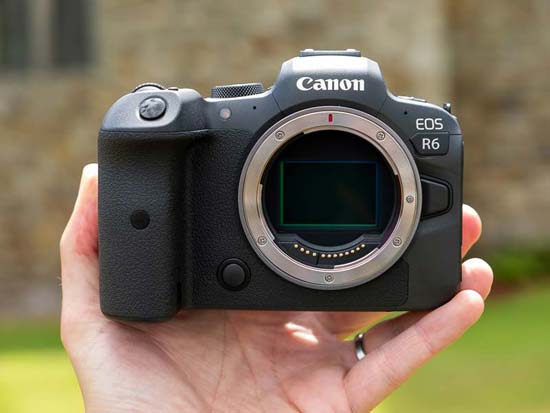
The EOS R6 has a 20 megapixel sensor that's very similar to the one found in the flagship EOS-1D X Mark III DSLR camera, but with a different low-pass filter construction.
The ISO range runs from 100-102,400, one stop more than the EOS R5. This can be further expanded up to ISO 204,800 and down to ISO 50.
4K Video
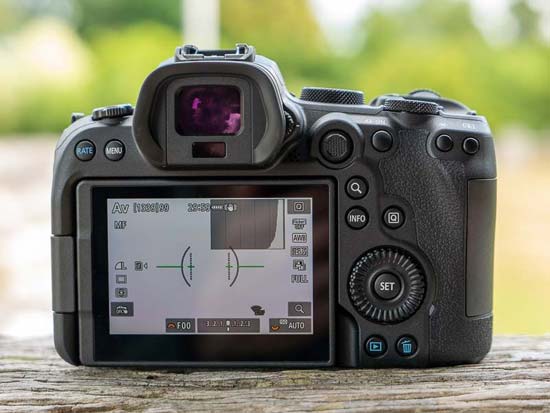
The Canon EOS R6 can record 4K video up to 60p in 10-bit, achieved through oversampling from 5.1K.
The camera can record internally in 8-bit H.264 or 10-bit YCbCr 4:2:2 H.265 and Canon Log.
Slow-motion footage is also available with AF support using Full HD at up to 120fps.
Dual Pixel CMOS AF II
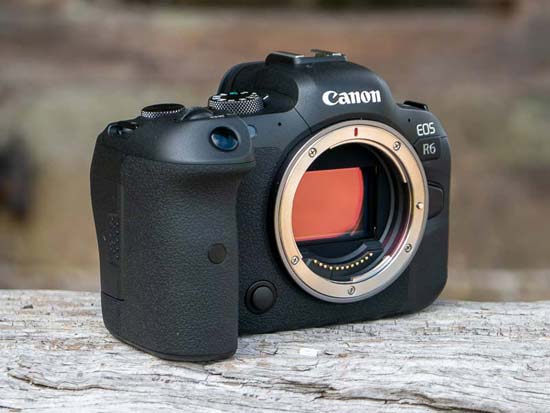
The next generation Dual Pixel CMOS AF II system on the EOS R6 offers the world’s fastest AF, with the camera capable of focusing in as little as 0.05 seconds. It has 6,072 selectable AF points, slightly more than the EOS R5.
Impressively the EOS R6 can also focus in light levels as low as -6.5EV, which is 0.5-stop better than the EOS R5.
Thanks to its Digic X processor, the EOS R6 offers exactly the same deep learning based automatic face, eye and animal AF tracking modes as the R5.
Handling
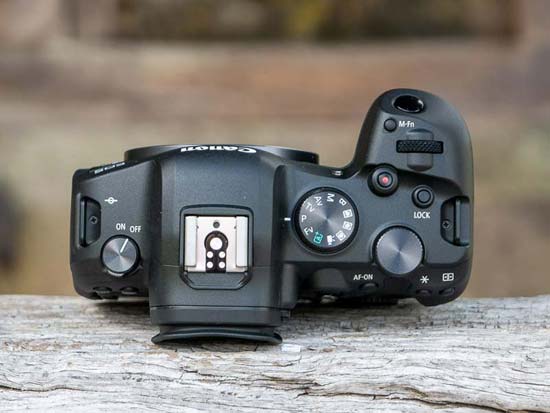
The design and ethos is reminiscent of the 60D and 7D DSLR lines being merged into one.
The EOS R6's back panel is exactly the same as on the EOS R5, but the top-plate is a little different.
Instead of the LCD status panel and Mode button found on top of the EOS R5, the R6 has a more conventional shooting mode dial on the right in place of the LCD panel, which we suspect some users will actually prefer.
The rear offers an array of controls that will be instantly familiar to anyone who has used an EOS 5-series camera before, including the classic Canon control wheel.
This means that the innovative / controversial (delete as appropriate) Mfn bar that made its debut on the EOS R is only conspicuous by its complete absence on the new EOS R6, with Canon explaining that a thumb-operated joystick was more appropriate for the new model's target audience.
While this may be true, we were struck by how high the joystick is positioned on the rear of the Canon R6 - almost inline with the centre of the viewfinder, rather than where the Info button is - which seems rather too high to find easily, especially compared with most other cameras that have this key control.
The Canon R6 also benefits from both a tilting LCD screen and dual memory card slots for the first time in Canon's fledging full-frame mirrrorless system (along with the R5).
Weight
The Canon EOS R6 weighs 1.50 lb / 680 g body only with a battery and memory card fitted.
LCD Screen
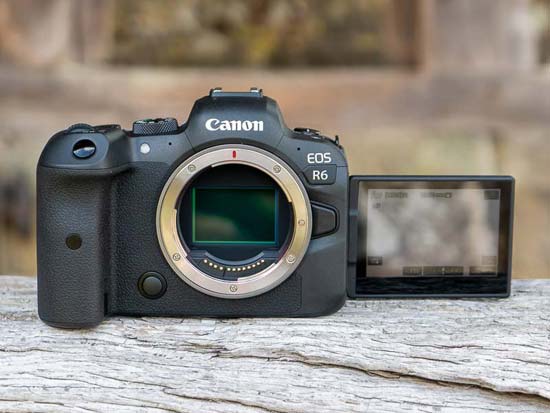
The EOS R6 has a pretty good 3-inch 1.62 million dot vari-angle LCD screen which encourages shooting from creative angles and makes the EOS R6 ideally suited to movie-shooting.
EVF
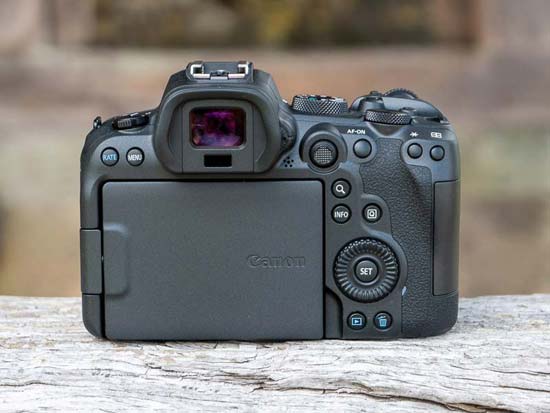
Although not quite as highly specced as the EOS R5, the 0.5inch 3.69 million dot EVF on the EOS R6 is still impressive to look through, working up to 120fps.
Build Quality

Despite the EOS R6 having a polycarbonate body rather than the EOS R5's magnesium alloy body, impressively it still offers the same level of weather-proofing as the EOS 6D Mark II DSLR.
8-stops Image Stabilisation
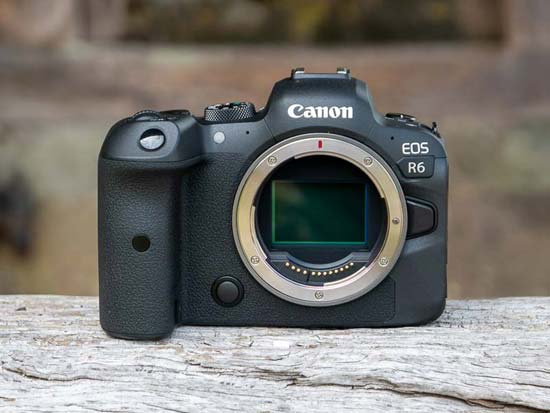
For the first time ever in the EOS series, the Canon EOS R6 incorporates 5-axis In-Body Image Stabilisation (IBIS), which has been designed to work collaboratively with the IS system of RF lenses.
The solution has been engineered so that RF lenses and the sensor work to correct pitch and yaw with the sensor correcting X-Y and roll movements.
This intelligent stabilisation system corrects at up to an incredible 8-stops – the world’s best image stabilisation – allowing you to hand-hold the camera for up to 4 seconds and still get sharp results.
Even better, the 54mm diameter of the of the RF Mount enables some non-IS RF lenses such as the RF 85mm F1.2L USM or RF 28-70mm F2L USM to also achieve up to 8-stops of image stabilisation.
The EOS R6 can also stabilise older, non-IS lenses including any EF lens that is fitted to the R6 via the Canon EF-EOS R mount adapter. Just think of all that vintage EF glass which will instantly be stabilized when mounted on the new EOS R6!
The stabilisation system will also work with lenses from other manufacturers – you just need to input the focal length into the camera's menu system.
20fps Burst Shooting
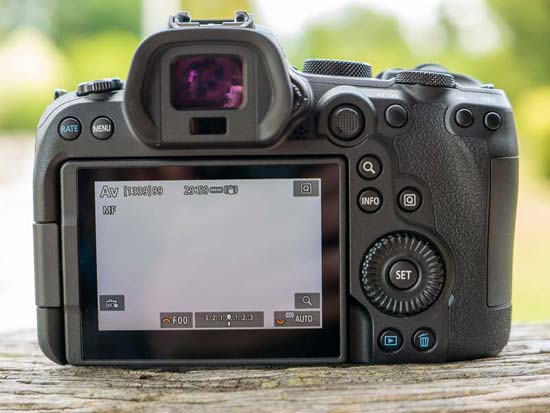
The EOS R6 offers continuous shooting at up to 20fps with the silent electronic shutter or 12fps with the mechanical shutter, both with full auto exposure (AE) and auto focus (AF) tracking.
Dual-card Slots
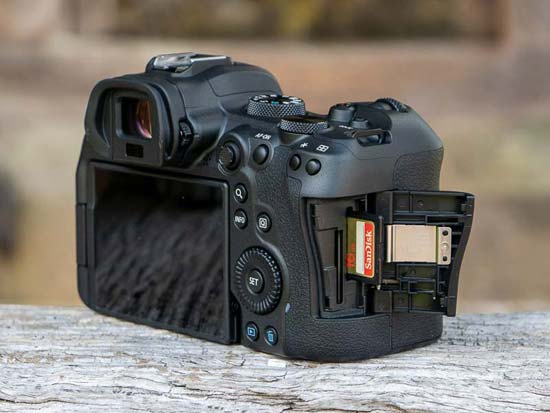
The EOS R6 supports two SD UHS II cards via dual slots.
Bluetooth and Wi-Fi
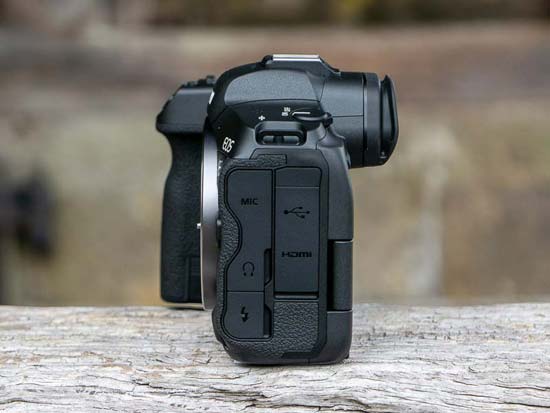
With built-in Bluetooth and 2.4Ghz Wi-Fi (slower than the EOS R5), the EOS R6 can be easily connected to a smartphone and networks allowing high-speed file sharing and FTP/FTPS transfer.
It can also be remotely controlled using the Camera Connect and EOS Utility apps and tethered to a PC or Mac via Wi-Fi or high-speed USB 3.1.
LP-E6NH Battery
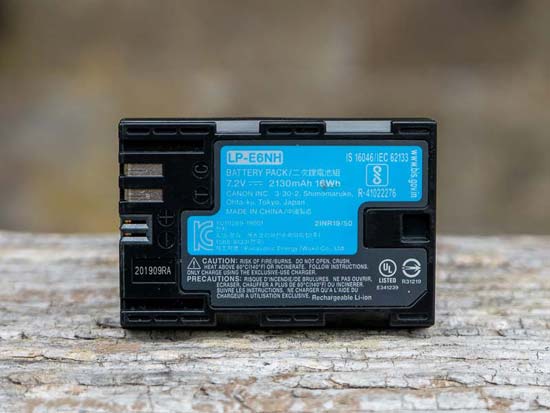
The LP-E6NH is a new longer life battery supplied with both the EOS R6 and EOS R5. It's backwards compatible with all existing cameras that use the LP-E6 series batteries. LP-E6NH replaces LP-E6N, with an increased capacity of 14% reaching 2130mAh.
BG-R10 Battery Grip
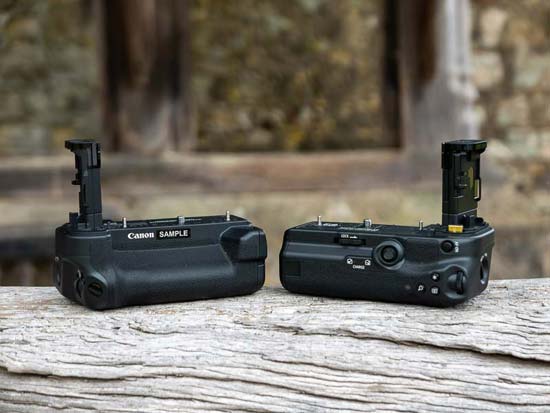
The same BG-R10 battery grip that the EOS R5 uses also gives users the ability to power the EOS R6 using two batteries (LP-E6/N/NH) and also offers duplicate controls for easier vertical shooting. Note that the batteries have to be charged whilst the grip is fitted on-camera.
Note that the new WFT-R10 Wi-Fi transmitter pictured above only works with the EOS R5, and not the EOS R6.
Early Verdict
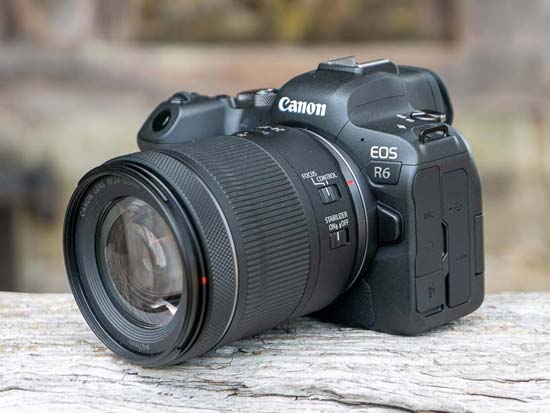
Somewhat inevitably the EOS R6 will be overshadowed at launch by the flagship EOS R5, but if you don't actually need 8K video, the R6 is a still very capable and much more affordable proposition that's a big step-up from the EOS R.
What do you think - does the EOS R6 set your pulse racing, or is it playing it too safe? Leave a comment below!
Image Gallery
Click on a thumbnail to see the full version.

Loading comments…